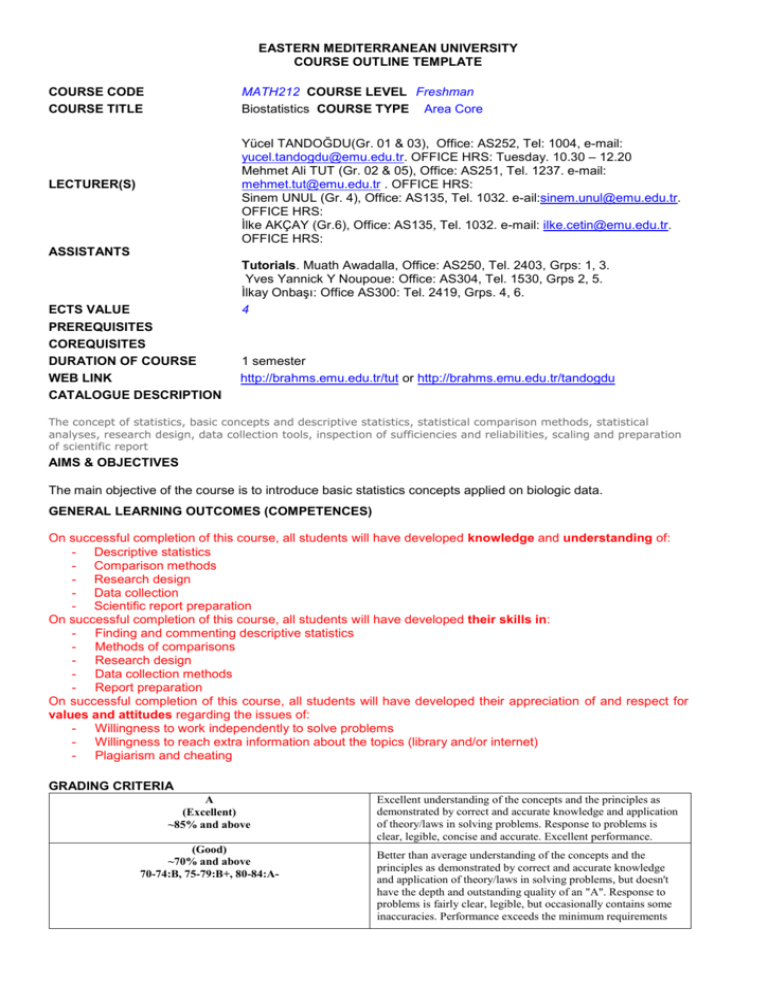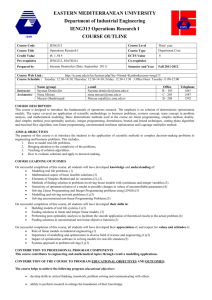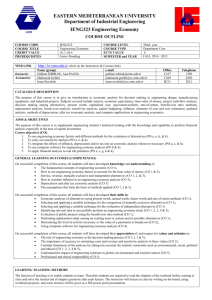The main objective of the course is to introduce basic statistics
advertisement

EASTERN MEDITERRANEAN UNIVERSITY COURSE OUTLINE TEMPLATE COURSE CODE COURSE TITLE MATH212 COURSE LEVEL Freshman Biostatistics COURSE TYPE Area Core LECTURER(S) Yücel TANDOĞDU(Gr. 01 & 03), Office: AS252, Tel: 1004, e-mail: yucel.tandogdu@emu.edu.tr. OFFICE HRS: Tuesday. 10.30 – 12.20 Mehmet Ali TUT (Gr. 02 & 05), Office: AS251, Tel. 1237. e-mail: mehmet.tut@emu.edu.tr . OFFICE HRS: Sinem UNUL (Gr. 4), Office: AS135, Tel. 1032. e-ail:sinem.unul@emu.edu.tr. OFFICE HRS: İlke AKÇAY (Gr.6), Office: AS135, Tel. 1032. e-mail: ilke.cetin@emu.edu.tr. OFFICE HRS: ASSISTANTS ECTS VALUE PREREQUISITES COREQUISITES DURATION OF COURSE WEB LINK CATALOGUE DESCRIPTION Tutorials. Muath Awadalla, Office: AS250, Tel. 2403, Grps: 1, 3. Yves Yannick Y Noupoue: Office: AS304, Tel. 1530, Grps 2, 5. İlkay Onbaşı: Office AS300: Tel. 2419, Grps. 4, 6. 4 1 semester http://brahms.emu.edu.tr/tut or http://brahms.emu.edu.tr/tandogdu The concept of statistics, basic concepts and descriptive statistics, statistical comparison methods, statistical analyses, research design, data collection tools, inspection of sufficiencies and reliabilities, scaling and preparation of scientific report AIMS & OBJECTIVES The main objective of the course is to introduce basic statistics concepts applied on biologic data. GENERAL LEARNING OUTCOMES (COMPETENCES) On successful completion of this course, all students will have developed knowledge and understanding of: - Descriptive statistics - Comparison methods - Research design - Data collection - Scientific report preparation On successful completion of this course, all students will have developed their skills in: - Finding and commenting descriptive statistics - Methods of comparisons - Research design - Data collection methods - Report preparation On successful completion of this course, all students will have developed their appreciation of and respect for values and attitudes regarding the issues of: - Willingness to work independently to solve problems - Willingness to reach extra information about the topics (library and/or internet) - Plagiarism and cheating GRADING CRITERIA A (Excellent) ~85% and above (Good) ~70% and above 70-74:B, 75-79:B+, 80-84:A- Excellent understanding of the concepts and the principles as demonstrated by correct and accurate knowledge and application of theory/laws in solving problems. Response to problems is clear, legible, concise and accurate. Excellent performance. Better than average understanding of the concepts and the principles as demonstrated by correct and accurate knowledge and application of theory/laws in solving problems, but doesn't have the depth and outstanding quality of an "A". Response to problems is fairly clear, legible, but occasionally contains some inaccuracies. Performance exceeds the minimum requirements An average understanding of the concepts and the principles as demonstrated by reasonably correct knowledge and application of theory/laws in solving problems, but doesn't have any depth. Response to problems is reasonably clear, legible, but contains inaccuracies. It reveals a sufficient understanding of the material, but lacks depth in understanding and approach/application. Content and form don't go beyond basic expectations and/or display some substantial errors. Acceptable but non-exceptional performance that doesn't go beyond the minimum requirements. Minimal knowledge and barely sufficient understanding of the concepts and the principles as demonstrated by approximately correct application of theory/laws in solving problems. Response to problems is not very clear and is barely legible, and contains many inaccuracies. It reveals a minimum (confused) understanding of the material, and lacks depth in understanding and approach/application. Content and form do not adequately meet the basic expectations, and/or display significant errors. Performance demonstrates severe problems in one or more areas. Work does not meet the most minimal standards. It reveals no understanding of the material, lack of basic academic skills and knowledge, or completely incomprehensible writing. Performance is not acceptable Conditions that might lead to NG grade. Above 50% absent in classes and exams (Average) ~60 % and above 60-62:C, 63-65:C+, 66-69:B- (Barely sufficient) ~50% and above 50-52:D, 53-55:D+, 56-59:C- (Fail) Below 50% 0-34:F, 35-49:DNG nil grade Note: The above intervals for letter grades may change depending on overall performance. RELATIONSHIP WITH OTHER COURSES The methods mentioned in the course will help the students to understand the discussions and comments in other courses about statistics in biologic data. LEARNING / TEACHING METHOD Reading and analysing lecture notes, class discussions, extra works on assigned exercises, quizzes labs and tutorials. ASSIGNMENTS Home study problems will be assigned at the end of each section. METHOD OF ASSESSMENT Midterm examination 35% Quizzes 20% Final Exam 45% ATTENDANCE Attendance is required. Students are responsible not only for the material presented and discussed, but also for any announcements made in class. Poor attendance may result NG grade TEXTBOOK/S Biostatistics: Basic Concepts and Methodology for the Health Sciences, Wayne W. Daniel, 10th Edition INDICATIVE BASIC READING LIST Lecture Notes SEMESTER OFFERRED: 2015-2016 Spring Semester CONTENT & SCHEDULE Lectures will be held on Period 08:30 09:30 10:30 11:30 Mon Tue MATH212(01) PHAR226 MATH212(02) CL105 MATH212(05) CL201 MATH212(06) CL210 MATH212(01) PHAR226 MATH212(02) CL105 MATH212(05) CL201 MATH212(06) CL210 Wed Thu MATH212(01) PHAR211 MATH212(02) CL111 MATH212(03) PHAR 218 MATH212(04) PHAR227 MATH212(01) PHAR211 MATH212(02) CL111 MATH212(03) PHAR 218 MATH212(04) PHAR227 MATH212(05) PHAR224 MATH212(06)PHAR219 MATH212(05) PHAR224 Fri MATH212(06)PHAR219 12:30 13:30 14:30 15:30 MATH212(03) PHAR218 MATH212(03) PHAR218 MATH212(04) PHAR219 MATH212(04) PHAR219 The lecture topics within the semester are as in the following schedule: WEEK 1 TOPICS CH1. Introduction to statistics and biostatistics. Some basic concepts, measurement and 2 measurement scales, sampling and statistical inference, the scientific method and the design of experiments.Computers and biostatistical analysis.Use of statistics in health sciences. CH2. The ordered array. Grouping data; pie chart, stem and leaf chart, frequency table, polygon, and ogive. 3 Estimation using ogive curve. CH2. Descriptive statistics. Measures of central tendency, mean, median, mode. Skewness, kurtosis. Quartiles, percentile. measures of dispersion. variance, standard deviation. 4 5 CH3. Arrangement of objects; permutations and combinations. Objective, relative frequency, and subjective probability. Elementary properties of probability. Quiz#1, 21/03/2016. CH3. Calculating the probability of an event. Conditional probability. Bayes’ Theorem, screening tests, sensitivity, specificity, and predictive value positive and negative. 6 7 8,9 10 CH4. Discrete Probability distributions. Bernoulli process and Binomial distribution. Poisson process and the Poisson distribution. CH4. Continuous probability distributions, the Normal distribution: reading the z table, prob. Copmputation of a normal r.v. Midterm Examinations Period. 8 – 20 Aprıl 2016 CH5. Sampling distributions. Distribution of the sample mean ( x ), distribution of the difference between two sample means ( x1 x2 ). 11 12 CH6. Estimating the confidence interval for a population mean ( ), t Distribution. CH6. Estimating the confidence interval for the difference between two population means. Quiz#2, 16 May 2016. 13 14 15 16 CH7. Hypothesis testing for a single population mean Sections 7.1, 7.2 Hypothesis testing the difference between two population means. Paired comparisons. Preparing scientific reports. Final Examinations. 31 May – 15 June 2016 Last day for submitting letter grades. 21 June 2016 PLAGIARISM Individual accountability for all individual work, written or oral. Copying from others or providing answers or information, written or oral, to others is cheating. Providing proper acknowledgment of original author. Copying from another student’s paper or from another text without written acknowledgement is plagiarism. According to University’s bylaws cheating and plagiarism are serious offences resulting in a failure from exam or project and disciplinary action (which includes an official warning may appear in student’s transcript or/and suspension from University for up to one semester). ANY OTHER USEFUL INFORMATION Attendance is compulsory. Students with poor attendance and not attended the exams will receive NG grade. A make-up exam will be given for the missed midterm examination. Students missing the Midterm, MUST provide an official report to the course instructor within 3 working days following the exam, in order to take the Make-up exam. NO make-up for missed quizzes.





